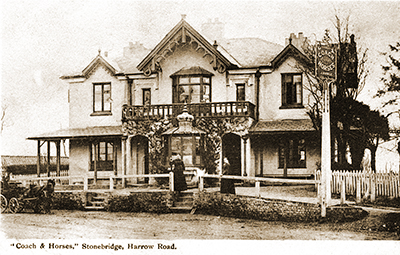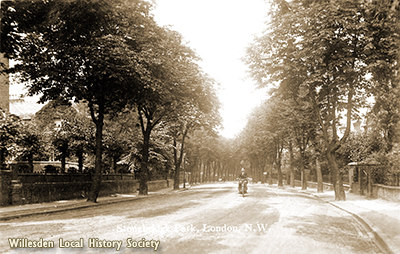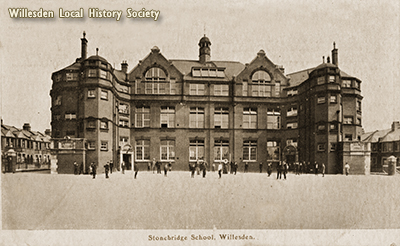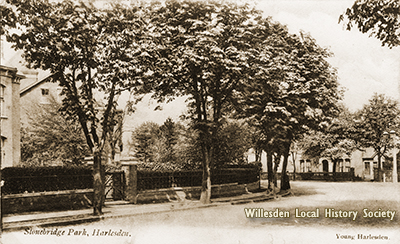
Stonebridge

Stonebridge lies on the east side of the River Brent, between Harlesden and Wembley. A small settlement grew up, where the Harrow Road crosses the Brent. The original crossing would have been a ford, passable only in good weather. The river could reach 14 feet in depth during storms, before the building of the dam at Kingsbury.
A bridge of stone and brick with two arches was built by the Lords of the Manor of Oakington and East Twyford, possibly between 1660 and 1700 AD. This gave Stonebridge its name. In 1746 four farm buildings were recorded, clustered near the bridge. The Coach and Horses inn was opened by 1790, providing stabling for horses, and hospitality for travellers on the road from London to Harrow.
The winding character of the River Brent caused problems at the Stonebridge crossing, where a large loop of the river flowed east and back to the west again, almost meeting itself. The loop was crossed by the bridge, and watered the farmland around it. When a storm occurred, the resulting flood of deep water would not flow round the loop, but took a shortcut across the “neck “and rushed on southward. Efforts were made to force the Brent to take the long way round, by putting in a weir, but the water eventually had its own way, and the shortcut became the main river. This left the stone bridge stranded on an “Oxbow ” lake, which was neglected, and eventually filled in. A new bridge was built to take the Harrow Road across the river, a short distance nearer to Wembley, around the end of the 19th century.
Another waterway can be seen crossing the Brentfield area of Stonebridge. A little feeder canal brings water from the Welsh Harp Reservoir in the north of Willesden, to top up the Grand Junction Canal, Paddington Arm, at Acton Lane. The Canal is the southern boundary of Stonebridge, and crosses the Brent Valley in an aqueduct high above the River Brent.
LOCAL RAILWAYS.
Robert Stephenson’s London to Birmingham Railway, or London North Western Railway, (now the London, Midland and Scottish) crosses the Brent Valley on a huge brick viaduct of 1837, the “Seven Arches” with its wide central arch to take the Brent in flood. The river has since been channelled on the Wembley side, and the North Circular Road passes under the viaduct beside the river. More bridges have been added to carry the line to Watford, and access to the Brent Sidings, to the west and east of the road.
The Midland and South West Junction Railway separates Stonebridge from Harlesden. When a passenger station opened at Craven Park, the railway was a stimulus for building the Stonebridge Park Estate, of 60 large villas for City men commuting into London. A large hotel, the Stonebridge Park Hotel, was built nearby on the Harrow Road. The hotel remains, but only two of the grand villas are left.
BUILDING STONEBRIDGE
After the ambitious Stonebridge Park Estate was finished in 1876, the people who next moved into the area were mostly tradesmen, or those in the retail trade, and the houses built were small terraces, beside the Harrow Road, and between Knatchbull Road and Stonebridge Recreation Ground, next to the London to Birmingham Railway. The section of Harrow Road through the Stonebridge area became known as Hillside, and this was the main shopping centre.
The Orange Tree pub was built on the north side of Hillside, and St Michael’s Church on the corner with Knatchbull Road, opened in 1901. Two large schools were built: Stonebridge Primary in 1900 and Wesley Road Council School, in 1910 to cater for the large families moving into the new terraces. Stonebridge School survives into the 21st century, Wesley Road is replaced by Our Lady of Lourdes R.C. Primary school.
The Willesden Isolation Hospital opened beside Brentfield Road (then called Dog Lane.)
INDUSTRY MOVES IN
Laundries, motor car works, dye works and other small industries opened in the area. A large electricity generating station was built at Taylor’s Lane, where water from the canal feeder was used for cooling. The Harlesden-Stonebridge tram route opened after 1901, with a depot at Stonebridge in 1906. This was the terminus for the electric trams until 1908, when the route was extended to Wembley. The Stonebridge depot was turned over to trolley buses in 1936, these were replaced by buses in 1962, and the depot closed in 1981. The building was replaced by a sports and community centre.
THE NORTH CIRCULAR ROAD, around North London, came through the area in 1921. Several bridges were built for it to pass beneath railway lines, though the main arch of the Stephenson viaduct was used under the LNWR, (by now the LMSR) while the River Brent was culverted to the west side of the new road. The North Circular nowadays goes through a new underpass. The Ace Cafe was opened in 1938, and quickly became a venue for bikers and a centre for 1950s Rock ‘n Roll. As well as being culverted beside the North Circular, the River Brent was straightened through the Tokyngton Recreation Ground, but this work was reversed in the early 21st century, and the river’s meanders were reinstated to help control flooding.
STONEBRIDGE HOUSING ESTATE
From 1957 there was a plan to redevelop a 100 acre site bounded by the railways and the Brentfield Estate. Late Victorian terraces around Hillside were swept away, and the first huge preformed- concrete tower blocks opened in 1967. The new estate had multi-storey car parks and a shopping precinct. Within 30 years, the estate had thrown up many problems, both in construction faults and in the social difficulties faced by residents. The estate was demolished, and the concrete giants were replaced by more family-friendly housing. The Coach and Horses and the Orange Tree did not survive, but Stonebridge Park Hotel, St Michael’s Church and Stonebridge School remain to remind us of the past. The latest victim of change is to be Altamira, one of the last two villas of the original Stonebridge Park Estate, due to be demolished and replaced by housing and a new Adult Education Centre.
Margaret Pratt, 2021



